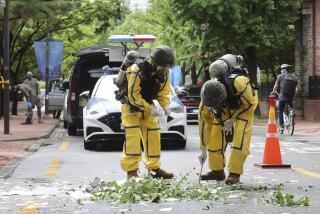Journalists take a tense yet colorful tour of Korean DMZ
- Share via
THE KOREAN DEMILITARIZED ZONE — The “Do Not Cross” line here between North and South Korea has a prosaic feel to it: a concrete speed bump.
The almost imperceptible hump, sitting between two blue buildings that straddle the 38th parallel, would look at home on a suburban street. Likewise, the swath of grass and concrete of the Joint Security Area resembles a college campus -- uncommonly quiet and devoid of students -- more than a hyper-guarded demilitarized zone.
But hyper-guarded it is. On the North Korean side, flanked by two armed soldiers, a repairman changes a lightbulb on an outdoor lamppost as scores of men on both sides monitor his progress in silence.
As I take a few steps toward Pyongyang, gingerly, a South Korean soldier dressed in a military police uniform stands nearby, his posture designed to intimidate nearby North Korean soldiers: fists clenched, dark sunglasses covering his eyes, even indoors. He reminds me of the CHP officers I’ve encountered while getting speeding tickets on L.A. freeways.
In recent weeks, the soldiers guarding the world’s most heavily defended border have had reason to frown. In late May, North Korea conducted an underground test of a nuclear device, a few days before threatening the South with a possible military attack.
The provocations have given the normally tense, several-mile-wide DMZ a heart-pounding edge. And nerves are especially jangling here, in the Joint Security Area, where soldiers from both sides sometimes come close enough to touch one another.
“The tension here is higher than ever,” South Korean Cpl. Yoo Hyun-woo says. “You’ll be able to feel it. So, please, do not point or gesture or try to communicate with the North Korean soldiers. Keep your voices low. Don’t do anything that might provoke them.”
Yoo -- my first-ever tour guide wearing a holstered handgun -- is shepherding a gaggle of journalists to the Joint Security Area so we can describe just how much the stakes have risen here.
But we have to do our jobs without talking to soldiers: Everyone in a uniform is off-limits for interviews. And the brass means business. When one happy-go-lucky radio reporter asks Yoo to repeat an earlier bit in front of her microphone, a steely-eyed commander pounces.
He points a finger in her face. “You’ve got a penalty,” he says, giving her a seething drill sergeant’s once-over. “I remember you.”
The Joint Security Area is the nerve center of the 150-mile-long DMZ, a modern-day Great Wall largely made up of concertina wire in the shape of a child’s circular scribbles, a no man’s land that carries a chilling but sometimes whimsical history.
Yoo tells stories of the “Bridge of No Return,” across which the sides exchanged prisoners in 1953. The men were allowed to make an irreversible choice as to which side of the DMZ they wanted to live on.
The bridge is also the site of the so-called 1976 Ax Murder Incident, in which two U.S. Army officers trimming a tree were killed by North Korean guards using axes, crowbars and clubs.
The killings, Yoo explains, resulted in Operation Paul Bunyan, one of the world’s largest military tree-pruning jobs.
Martial arts experts and combat engineers cut back the tree, backed by B-52 bombers, attack helicopters -- and even the aircraft carrier Midway, which sat just offshore.
“Needless to say, the North Koreans didn’t interfere with our tree-trimming operation,” Yoo deadpans.
Until recently, better manners had returned to the DMZ.
Bang Joon-hyuk, a South Korean college student who once pulled military duty here, tells of horseplay between the two sides.
North Koreans at the JSA often whistled at Southern soldiers at night and once floated across a paper airplane. The two sides never spoke, but Bang says he often heard the North Koreans mimicking the Southern soldiers’ markedly different accents.
“At first you feel really nervous being there,” he recalls, “but later it is nothing.”
Toward the end, “tour guide” Yoo stands atop Checkpoint Three, an allied outpost surrounded by rolling woodland. He points to a small house where on July 27, 1953, the armistice was signed to end the bloodshed on the Korean peninsula.
“On three sides,” Yoo says, waving his hand, “we’re surrounded by hostile communist territory.”
Nearby, a white crane dips its wing to catch an updraft, soaring elegantly aloft, unknowingly crossing the border between North and South.
--
Ju-min Park in The Times’ Seoul Bureau contributed to this report.
More to Read
Sign up for Essential California
The most important California stories and recommendations in your inbox every morning.
You may occasionally receive promotional content from the Los Angeles Times.











